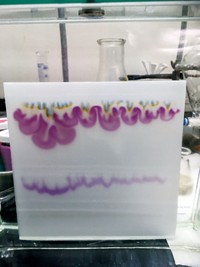Advertisement
Grab your lab coat. Let's get started
Welcome!
Welcome!
Create an account below to get 6 C&EN articles per month, receive newsletters and more - all free.
It seems this is your first time logging in online. Please enter the following information to continue.
As an ACS member you automatically get access to this site. All we need is few more details to create your reading experience.
Not you? Sign in with a different account.
Not you? Sign in with a different account.
ERROR 1
ERROR 1
ERROR 2
ERROR 2
ERROR 2
ERROR 2
ERROR 2
Password and Confirm password must match.
If you have an ACS member number, please enter it here so we can link this account to your membership. (optional)
ERROR 2
ACS values your privacy. By submitting your information, you are gaining access to C&EN and subscribing to our weekly newsletter. We use the information you provide to make your reading experience better, and we will never sell your data to third party members.
Education
Newscripts
A closer look at luxe
by Alexandra A. Taylor
January 1, 2018
| A version of this story appeared in
Volume 96, Issue 1
Bubbles ring in new year

It’s said that you can tell a champagne’s quality by the size of its bubbles: the smaller the bubbles, the better the champagne. Though the theory is unconfirmed, one possible explanation is that sparkling wine naturally loses some carbonation as it ages, which leads to more delicate bubbles in older champagnes. When Kyle Spratt and his coworkers at Applied Research Laboratories at the University of Texas, Austin, learned of this theory, they decided to use their scientific expertise to study the effervescence. “Once we heard that the bubble size was important for champagne, we naturally thought, Why don’t we try to determine the bubble size acoustically?” Spratt tells Newscripts. He and his team, which primarily studies underwater acoustics for sonar applications, presented their method at the Acoustical Society of America conference in New Orleans last month.
Initially, a bubble nucleates on the side of its container; when it breaks off, it rings at a certain frequency. Smaller bubbles ring at higher pitches. To determine bubble size, Spratt and colleagues dunked a hydrophone, or underwater microphone, into a glass of bubbly and listened. They tried different cups to see what effect the drinking vessel might have on bubble formation before settling on a champagne flute, the most classic container.
The bubbles from the higher-quality champagne, Moët & Chandon, rang at a slightly higher pitch than the bubbles produced by Cook’s, a less expensive sparkling wine. The bubbles emit a high-pitched pinging or crackling sound, and it’s difficult to differentiate the two wines by sound alone. The researchers had to analyze the data to measure the differences between the bottles. Based on this work, they found that the Moët & Chandon bubbles were about 5% smaller in diameter and that the fancy bottle had three times as many bubbles as the Cook’s bottle.
So far, they’ve reported data on only two bottles. Spratt imagines future applications such as quality-assurance tests for manufacturers looking for bubble consistency in each batch. But for now, he and his team are tinkering with their process. Next they plan to test a range of champagnes to see whether they can correlate bubble size with price or rating, or whether the theory is all fizz.
Chemists balk at fenestral blunder

When University of Minnesota, Twin Cities, postdoc Addison Desnoyer first saw a photo of a window display at the Tiffany & Co. flagship store in New York City, he was excited that it featured glass chemistry equipment. However, his joy turned to disappointment once he realized that it had been improperly assembled. “The display features some of the most beautiful pieces of glassware you’ll find in a synthetic chemistry lab,” Desnoyer says. “Unfortunately, due to the setup, none of these assemblies would be able to function as they were designed to.”
Desnoyer took to social media to vent his frustrations, and he wasn’t alone. On Facebook, Cassie Hancock quipped, “This set up reminds me of grad school where you pieced together what wasn’t broken and hoped for the best.” Sion Phillips lamented, “The condenser running into a funnel over a flask makes me want to cry.” With a few changes, such as adding adapters to fit the flasks to the condensers and extractor, the setup could be corrected, Desnoyer says. He adds, “Accuracy will score you major bonus points with the scientific community.”
Alexandra Taylor wrote this week’s column. Please send comments and suggestions to newscripts@acs.org.





Join the conversation
Contact the reporter
Submit a Letter to the Editor for publication
Engage with us on Twitter